Navigation
Geckos Adhere to Surfaces Submerged Underwater: Study May Help Inform Future Bio-Inspired Gecko-Like Adhesives
“The geckos stuck just as well under water as they did on a dry surface, as long as the surface was hydrophobic [water-loving],” Stark explains. “We believe this is how geckos stick to wet leaves and tree trunks in their natural environment.”
The study has implications for the design of a synthetic gecko-inspired adhesive. Geckos' ability to stick to trees and leaves during rainforest downpours has fascinated scientists for decades, leading a group of University of Akron researchers to solve the mystery.
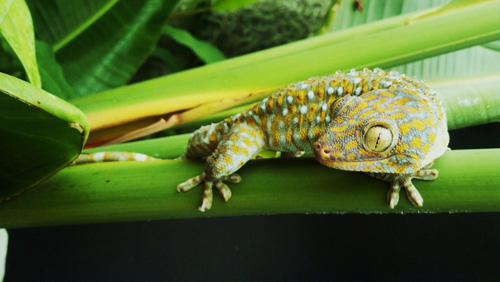 Geckos maintain their grip on wet hydrophobic surfaces such as those of leaves and tree trunks.: This discovery was made by University of Akron researcher, integrated bioscience doctoral candidate Alyssa Stark, principal investigator, and her colleagues Ila Badge, Nicholas Wucinich, Timothy Sullivan, Peter Niewiarowski and Ali Dhinojwala. Photograph by Alyssa Stark of The University of Akron
Geckos maintain their grip on wet hydrophobic surfaces such as those of leaves and tree trunks.: This discovery was made by University of Akron researcher, integrated bioscience doctoral candidate Alyssa Stark, principal investigator, and her colleagues Ila Badge, Nicholas Wucinich, Timothy Sullivan, Peter Niewiarowski and Ali Dhinojwala. Photograph by Alyssa Stark of The University of Akron
The gecko is a fascinating creature, able to perform remarkable maneuvers, not quite as many as are depicted in Geico Insurance commercials, but quite remarkable nonetheless. They use their sticky adhesive toes stick to, climb on, and run along surfaces in any orientation, including, unlike precarious human rock climbers, to even move along upside down without fear of falling! And, as to sight, most geckos cannot blink. But does that stop them. No. They compensate for this, by enlarging their fixed lens within each iris, they can see in darkness. Not quite as articulate as the gecko in the Geico ads, geckos, unique among lizards in their vocalizations, use chirping sounds to communicate with other geckos.
 A gecko (Lepidodactylus lugubris) moves easily across smooth plant structures, such as the flowers: shown here, in any orientation with the help of their adhesive toe pads. Photographed on Moorea, French Polynesia by Edward A. Ramirez and Peter H. Niewiarowski
A gecko (Lepidodactylus lugubris) moves easily across smooth plant structures, such as the flowers: shown here, in any orientation with the help of their adhesive toe pads. Photographed on Moorea, French Polynesia by Edward A. Ramirez and Peter H. Niewiarowski
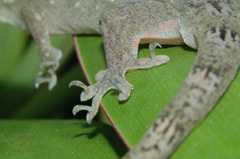 The shape of gecko toe pads as well as their claw structure varies across species.: For instance, the gecko shown here (Gehyra oceanica) has retractable claws that work independently of the toe. The function of this feature is still unknown but likely has to due with the type of surfaces they move across in their natural environment. Photographed on Moorea, French Polynesia by Edward A. Ramirez and Peter H. NiewiarowskiHow do they manage their acrobatic feats? Until recently, it was not well understood how geckos kept their sticking ability, an ability to stick even on wet surfaces, common in the tropical regions in which most geckos live.
The shape of gecko toe pads as well as their claw structure varies across species.: For instance, the gecko shown here (Gehyra oceanica) has retractable claws that work independently of the toe. The function of this feature is still unknown but likely has to due with the type of surfaces they move across in their natural environment. Photographed on Moorea, French Polynesia by Edward A. Ramirez and Peter H. NiewiarowskiHow do they manage their acrobatic feats? Until recently, it was not well understood how geckos kept their sticking ability, an ability to stick even on wet surfaces, common in the tropical regions in which most geckos live.
Geckos are known for their sticky adhesive toes that allow them to stick to, climb on, and run along surfaces in any orientation--even upside down! But until recently, it was not well understood how geckos kept their sticking ability even on wet surfaces, as are common in the tropical regions in which most geckos live.
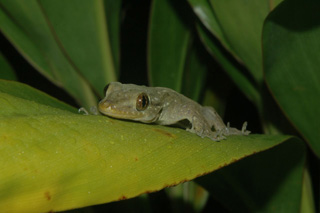 A gecko (Gehyra oceanica) easily scales a leaf covered with water droplets while searching for prey at night.: Photographed on Moorea, French Polynesia by Edward A. Ramirez and Peter H. Niewiarowski
A gecko (Gehyra oceanica) easily scales a leaf covered with water droplets while searching for prey at night.: Photographed on Moorea, French Polynesia by Edward A. Ramirez and Peter H. Niewiarowski
A 2012 study in which geckos slipped on wet glass perplexed scientists trying to unlock the key to gecko adhesion in climates with plentiful rain and moisture.
A study supported by the National Science Foundation and published in the Proceedings of the National Academy of Sciences April 1, 2013 solves the mystery, showing that wet, water-repellant surfaces, like those of leaves and tree trunks, actually secure a gecko's grip in a manner similar to dry surfaces.
Gecko Adhesive System
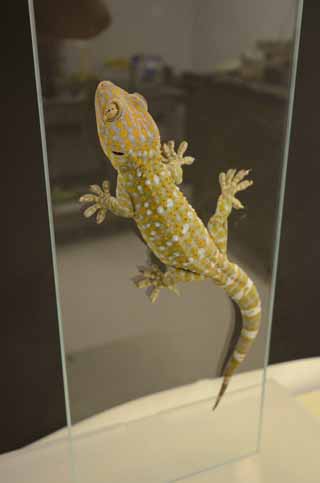 A Tokay gecko (Gekko gecko) clings to a smooth glass surface. Flattened toe pads equipped with strips: of microscopic hairs allow these geckos to stick to surfaces using simple van der Waals attractive forces rather than glue, like most commercially available tapes. As a response, a gecko does not leave behind any noticeable residue and can re-use their sticky pads multiple times, allowing them to run, jump and sit in any orientation, including upside-down. Most previous reports test geckos on smooth glass surfaces which are dry (as shown here) however studies by Alyssa Stark and colleagues tested geckos on wet surfaces which were hydrophobic or "water repellent" and those that were hydrophilic "water loving" like glass. Text Alyssa Stark, Photograph courtesy of University of Akron
A Tokay gecko (Gekko gecko) clings to a smooth glass surface. Flattened toe pads equipped with strips: of microscopic hairs allow these geckos to stick to surfaces using simple van der Waals attractive forces rather than glue, like most commercially available tapes. As a response, a gecko does not leave behind any noticeable residue and can re-use their sticky pads multiple times, allowing them to run, jump and sit in any orientation, including upside-down. Most previous reports test geckos on smooth glass surfaces which are dry (as shown here) however studies by Alyssa Stark and colleagues tested geckos on wet surfaces which were hydrophobic or "water repellent" and those that were hydrophilic "water loving" like glass. Text Alyssa Stark, Photograph courtesy of University of Akron
Researchers from the University of Akron, led by integrated bioscience doctoral candidate Alyssa Stark, tested the adhesive qualities of gecko pads, which have tiny, clingy hairs on four surfaces ranging from hydrophilic (water loving) on which liquids spread across when wet, like glass, to hydrophobic (water-repellent) on which liquids bead, like the natural leaves geckos walk on.
They tested intermediate surfaces like acrylic sheets. Geckos were tested on these surfaces both when the surfaces were dry and when they were submerged underwater, and water completely covered the gecko's feet.
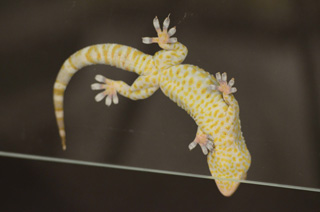 Photograph courtesy of University of Akron
Photograph courtesy of University of Akron
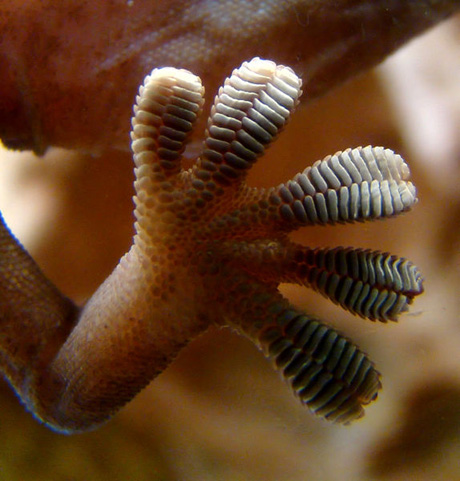 Close-up of the underside of a gecko's foot as it walks on a glass wall. Van der Waals force interactions: between the finely divided setae (hairs on the toes) and the glass enables the gecko to stay in place and walk on the seemingly smooth glass. Photograph by Bjørn Christian Tørrissen from Wikipedia
Close-up of the underside of a gecko's foot as it walks on a glass wall. Van der Waals force interactions: between the finely divided setae (hairs on the toes) and the glass enables the gecko to stay in place and walk on the seemingly smooth glass. Photograph by Bjørn Christian Tørrissen from Wikipedia
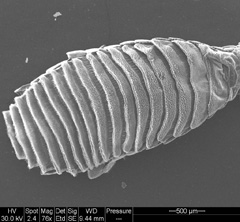 The small, hair-like adhesive setae form ordered mats on the gecko toe pad. In many species individual: hairs branch and terminate into flattened tips, called spatulae, which are responsible for making the close contact required for van der Waals forces- the primary mechanism behind the gecko's ability to stick. The hairs themselves are too small to be seen by the naked eye. Scanning electron microscope (SEM) photographs by Timothy Sullivan
The small, hair-like adhesive setae form ordered mats on the gecko toe pad. In many species individual: hairs branch and terminate into flattened tips, called spatulae, which are responsible for making the close contact required for van der Waals forces- the primary mechanism behind the gecko's ability to stick. The hairs themselves are too small to be seen by the naked eye. Scanning electron microscope (SEM) photographs by Timothy Sullivan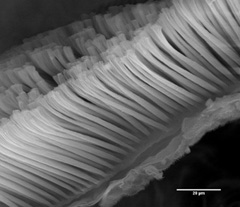 The small, hair-like adhesive setae
The small, hair-like adhesive setae
The scientists studied the clinging power of six geckos, which they outfitted with harnesses around their pelvis, and tugged upon gently as the lizards clung to surfaces in wet and dry conditions.
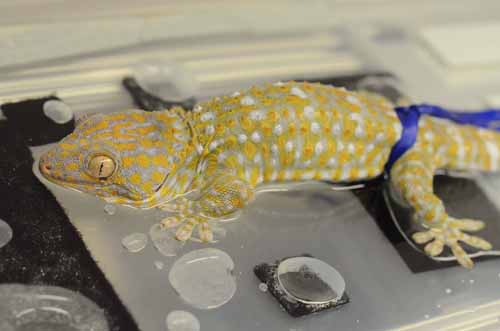 A Tokay gecko (Gekko gecko) clings to a smooth hydrophobic (water repellent) surface submerged underwater.: Small harnesses (blue ribbons) are secured around the waist of the gecko and are attached to a force sensor which logs the force a gecko can stick as it is slowly slid backwards at a controlled rate. As the gecko cling to the surface the sensor reads higher and higher forces until all four feet slip, which is recorded by researchers as the maximum force a gecko can sustain. Unlike results on hydrophilic glass (a "water loving" surface) geckos stuck equally well on the smooth hydrophobic surface underwater as they did when the surface was dry and tested in air. This suggests that geckos are able to maintain adhesion to wet hydrophobic surfaces in their natural environment like wet leaves and other plant structures. Text Alyssa Stark, Photograph courtesy of University of Akron
A Tokay gecko (Gekko gecko) clings to a smooth hydrophobic (water repellent) surface submerged underwater.: Small harnesses (blue ribbons) are secured around the waist of the gecko and are attached to a force sensor which logs the force a gecko can stick as it is slowly slid backwards at a controlled rate. As the gecko cling to the surface the sensor reads higher and higher forces until all four feet slip, which is recorded by researchers as the maximum force a gecko can sustain. Unlike results on hydrophilic glass (a "water loving" surface) geckos stuck equally well on the smooth hydrophobic surface underwater as they did when the surface was dry and tested in air. This suggests that geckos are able to maintain adhesion to wet hydrophobic surfaces in their natural environment like wet leaves and other plant structures. Text Alyssa Stark, Photograph courtesy of University of Akron
The geckos were gently pulled along the substrate until their feet began to slip. At this point, the maximum force with which a gecko could stick was measured. On wet glass geckos slipped and could not maintain adhesion.
However, when tested on more hydrophobic surfaces, geckos stuck just as well to the wet surface as they did to the dry ones. When tested, geckos stuck even better to wet Teflon than dry.
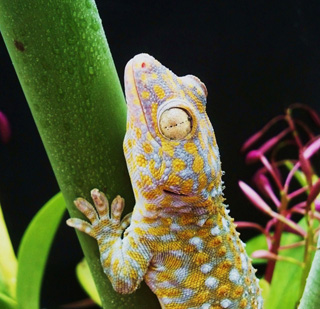 A tokay gecko (Gekko gecko) clings to leaf stem wet with water droplets.: Photograph by Alyssa Stark of The University of Akron“The researchers found that the effect of water on adhesive strength correlates with wettability, or the ability of a liquid to maintain contact with a solid surface,” according to Geckos keep firm grip in wet natural habitat: The University of Akron News.
A tokay gecko (Gekko gecko) clings to leaf stem wet with water droplets.: Photograph by Alyssa Stark of The University of Akron“The researchers found that the effect of water on adhesive strength correlates with wettability, or the ability of a liquid to maintain contact with a solid surface,” according to Geckos keep firm grip in wet natural habitat: The University of Akron News.
“On glass, which has high wettability, a film of water forms between the surface and the gecko’s foot, decreasing adhesion.”
Conversely, on surfaces with low wettability, such as waxy leaves on tropical plants, the areas in contact with the gecko’s toes remain dry and adhesion, firm.
“The geckos stuck just as well under water as they did on a dry surface, as long as the surface was hydrophobic,” Stark explains. “We believe this is how geckos stick to wet leaves and tree trunks in their natural environment.”
Testing how geckos make choices is very difficult. Our group is interested in how they use their adhesive system in natural environments, however, it is hard to test and observe geckos in the field. While we have experience doing field work using the CRIOBE field station on the island of Moorea in French Polynesia, an island right next to the main island of Tahiti, we have found laboratory work useful to test scenarios that investigate how geckos may utilize their system in a more controlled "natural-like" environment.
“Specifically, I questioned what the effect of rain and wet surfaces have on gecko adhesion,’ said Stark. “We know many geckos live in the tropics but we don't know if they can use their system when the surfaces they walk on or run along are wet.
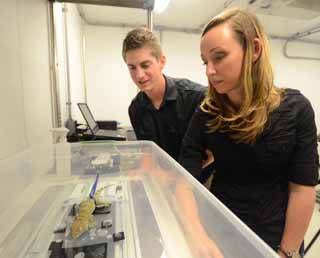 "Alyssa Stark, PhD candidate in Integrated Bioscience and Timothy Sullivan, undergraduate student in Biology: at the University of Akron." Photograph courtesy of University of Akron
"Alyssa Stark, PhD candidate in Integrated Bioscience and Timothy Sullivan, undergraduate student in Biology: at the University of Akron." Photograph courtesy of University of Akron
It was “because we didn't know what to expect we tried every combination of scenarios we though could be relevant and possible in nature,” said Stark. “This included wet and dry feet each tested on dry glass, misted glass (simulated rain droplets) and underwater. We were surprised that the geckos really didn't fare well... this is what motivated us to take a closer look at the surface we were testing them on. Hydrophilic glass is not very similar to the surfaces we would expect to see them on.
“For instance, a leaf is hydrophobic, which is why you see droplets of water bead up and roll off leaves easily. The gecko toes actually do this as well. We suspect many species are using leaves and other plant structures that are hydrophobic. So in our 2013 study, we changed surface type and kept water constant (all were tested underwater). That is where we made the discovery that water actually isn't such a problem for geckos walking on hydrophobic surfaces like wet leaves.
“With the help of colleagues in polymer science, we were even able to mathematically model this behavior with a simplified gecko-hair like surface, matching the theoretical results to our experimental results with the geckos.
“We found various results, including almost complete loss of adhesion under certain conditions. This was surprising to us because it suggests that geckos would have to avoid wet surfaces, altering their behavior significantly if they live in the tropics.
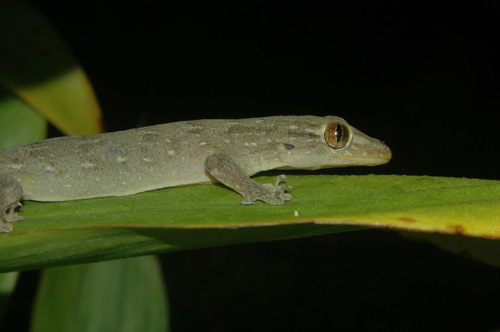 Most species of gecko, such as those shown here (Gehyra oceanica) are nocturnal and lack eyelids.: Nocturnal geckos have excellent night vision which allows them to navigate easily through their environment while they search for prey. Photographed on Moorea, French Polynesia by Edward A. Ramirez and Peter H. Niewiarowski
Most species of gecko, such as those shown here (Gehyra oceanica) are nocturnal and lack eyelids.: Nocturnal geckos have excellent night vision which allows them to navigate easily through their environment while they search for prey. Photographed on Moorea, French Polynesia by Edward A. Ramirez and Peter H. Niewiarowski
"Thinking back to their natural environment, we realized that the smooth hydrophilic glass surface on which we, and most other laboratories, test geckos on may not best represent what they normally walk on. Leaves for example are hydrophobic. When we tested geckos on wet hydrophobic surfaces we got our answer: they can stick!”
(This report is available at: http://www.pnas.org/content/110/16/6340.full)
To understand these findings, a National Science Foundation article of April 4, 2013 reported, researchers developed a model that explains the results from the gecko study and may also help inform future bio-inspired gecko-like adhesives that can maintain adhesion underwater.
As Stark pointed out, despite profound interest in the mechanics and performance of the gecko adhesive system, relatively few studies have focused on performance under conditions that are ecologically relevant to the natural habitats of geckos.
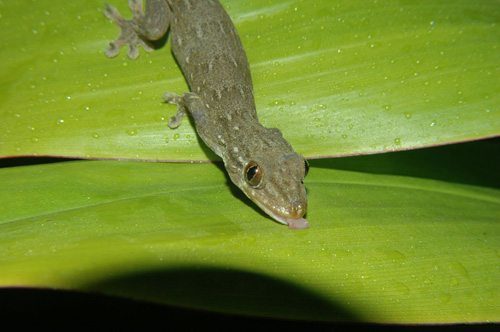 A gecko (Gehyra oceanica) uses its tongue to lick water droplets left behind by a recent rainstorm. Geckos primarily eat insects: , such as moths, though some species have been known to eat fruit and nectar from flowers. Photographed on Moorea, French Polynesia by Edward A. Ramirez and Peter H. Niewiarowski
A gecko (Gehyra oceanica) uses its tongue to lick water droplets left behind by a recent rainstorm. Geckos primarily eat insects: , such as moths, though some species have been known to eat fruit and nectar from flowers. Photographed on Moorea, French Polynesia by Edward A. Ramirez and Peter H. Niewiarowski
“Because geckos are likely to encounter surfaces that are wet, we used shear force adhesion measurements to examine the effect of surface water and toe pad wetting on the whole-animal performance of a tropical-dwelling gecko (Gekko gecko),” Stark explained.
In addition to measuring the shear adhesive force of geckos on three substrate conditions: dry glass, glass misted with water droplets and glass fully submerged in water, Stark said that they also investigated the effect of wetting on the adhesive toe pad by soaking the toe pads prior to testing. Then, they tested for repeatability of the adhesive system in each wetting condition by measuring shear adhesion after each step a gecko made under treatment conditions.
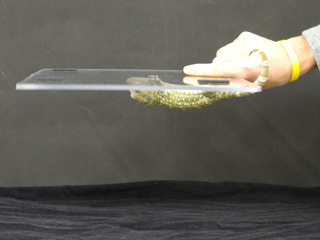 “They actually can spend a good amount of time upside-down. In Tahiti we often found them feeding: near ceiling lights which attracted moths and other flying insects. They sit and wait for their prey and run to chase after it easily upside-down.” Photograph by Alyssa Stark, The University of Akron
“They actually can spend a good amount of time upside-down. In Tahiti we often found them feeding: near ceiling lights which attracted moths and other flying insects. They sit and wait for their prey and run to chase after it easily upside-down.” Photograph by Alyssa Stark, The University of Akron
“Wetted toe pads had significantly lower shear adhesive force in all treatments (0.86±0.09 N) than the control (17.96±3.42 N), as did full immersion in water (0.44±0.03 N),” Stark said. “Treatments with droplets of water distributed across the surface were more variable and did not differ from treatments where the surface was dry (4.72±1.59 N misted glass; 9.76±2.81 N dry glass), except after the gecko took multiple steps.
“These findings suggest that surface water and the wetting of a gecko's adhesive toe pads may have significant consequences for the ecology and behavior of geckos living in tropical environments.”
“Basically my next step,” Stark said, “was to take what I learned about walking on wet surfaces from the first study in 2012, pair this with our findings of successful clinging underwater to hydrophobic surfaces in the 2013 study and ask the question: How does water (droplets similar to rain is this case) impact running speed when geckos run horizontally and vertically on misted hydrophilic and hydrophobic surfaces?
“This, as you may guess, is much more relevant to their natural behavior, as geckos often sit and wait for their prey and then do a quick run to catch it or in some cases they themselves are prey and need to run away from a bigger predator.
"What happens if the surfaces they are clinging to become wet with water droplets from rain? Can they catch their prey or evade predators with no impact on sprint speed? As we found, they can!
“We did find, however, that one gecko species from the desert slips more frequently on wet glass [than the geckos from the tropics], so perhaps geckos from the tropics are more optimized for wet surfaces? ...and thus the story continues!
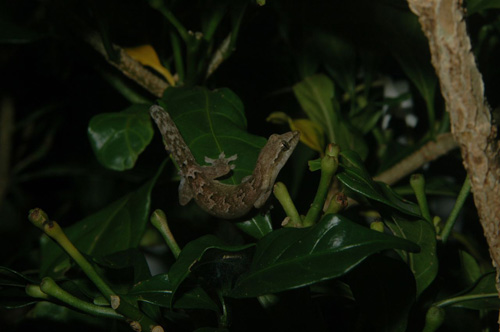 “By controlling a bit of the variation found in natural environments, keying in on only one feature,: such as surface chemistry for example, we have the opportunity to start to slowly decipher what they may be capable of in their natural environment,” said Stark. Photographed on Moorea, French Polynesia by Edward A. Ramirez and Peter H. Niewiarowski
“By controlling a bit of the variation found in natural environments, keying in on only one feature,: such as surface chemistry for example, we have the opportunity to start to slowly decipher what they may be capable of in their natural environment,” said Stark. Photographed on Moorea, French Polynesia by Edward A. Ramirez and Peter H. Niewiarowski
When asked about their ongoing gecko studies, Stark said that they still know relatively little about how geckos use their adhesive system or if geckos make active decisions about when to use it and when not to.
This and several other questions are now being addressed in studies done through the Integrated Bioscience PhD program together with their colleagues in polymer science.
“This collaboration will help us to discover more about the natural adhesive system of the gecko and how it works in their native habitats and also help us to design and create synthetic mimics, similar to the one created by my lab mates and co-adviser in polymer science,” said Stark. (link: http://www.pnas.org/content/104/26/10792.short).
Asked about the care of the geckos used in their studies, Stark provided this description:
“All experimental work has been approved by the University of Akron IACUC protocol 07-4G and is consistent with guidelines published by the Society for the Study of Amphibians and Reptiles (SSAR 2004). Our geckos are cared for by a team of undergraduate and graduate students who feed, clean and care for each of our animals. Our colony consists of about 50 individuals. We feed them cockroaches or crickets and some species get fruit supplements in the form of fruit baby food. We mist their individual enclosures two times a day too keep the humidity levels up and they are housed in a temperature controlled room.
“Our experiments are non-invasive so we often use the same animals repeatedly on different projects, therefore long-term care is very important to us. Likewise, in the field we catch all of our experimental animals with the intention of returning them back to the same area we found them, generally within a few days.
“Often we can find geckos on man-made structures around our field station however some species are more prevalent in forested areas, it just depends on what type of gecko we plan to use. In the lab we are able to order geckos from a reptile supplier and we can choose from a greater diversity of species.”
This news is from The National Science Foundation (NSF), 4 April 2013, from correspondence with Alyssa Stark, and from Alyssa Stark’s published reports indicated in the article and related links below.
Published on the Horizon International Solutions Site on 18 July 29013.
Notes:
For more details, see: Geckos keep firm grip in wet natural habitat.
More Related Links:
Journal of Experimental Biology: http://jeb.biologists.org/content/215/17/3080.short
Geckos as inspiration for innovation and new adhesives, an interview with Ali Dhinojwala: http://www.uakron.edu/innovation/gecko.dot
7/16/13 Geckos keep firm grip in wet natural habitat: The University of Akron News
The Guardian: http://www.guardian.co.uk/science/blog/2009/aug/05/gecko-grip-adhesion-gravity
The Journal of Experimental Biology 215, 3080-3086 © 2012. Published by The Company of Biologists Ltd doi:10.1242/jeb.070912
27.1 Adhesion - The Effect of Water on the Gecko Adhesive System http://sicb.zerista.com/event/member/70979
The gecko: an environmentally friendly biological agent for mosquito control. Med Vet Entomol. 1997 Oct;11(4):319-23.
Search
Latest articles
Agriculture
- World Water Week: Healthy ecosystems essential to human health: from coronavirus to malnutrition Online session Wednesday 24 August 17:00-18:20
- World Water Week: Healthy ecosystems essential to human health: from coronavirus to malnutrition Online session Wednesday 24 August 17:00-18:20
Air Pollution
- "Water and Sanitation-Related Diseases and the Changing Environment: Challenges, Interventions, and Preventive Measures" Volume 2 Is Now Available
- Global Innovation Exchange Co-Created by Horizon International, USAID, Bill and Melinda Gates Foundation and Others
Biodiversity
- It is time for international mobilization against climate change
- World Water Week: Healthy ecosystems essential to human health: from coronavirus to malnutrition Online session Wednesday 24 August 17:00-18:20
Desertification
- World Water Week: Healthy ecosystems essential to human health: from coronavirus to malnutrition Online session Wednesday 24 August 17:00-18:20
- UN Food Systems Summit Receives Over 1,200 Ideas to Help Meet Sustainable Development Goals
Endangered Species
- Mangrove Action Project Collaborates to Restore and Preserve Mangrove Ecosystems
- Coral Research in Palau offers a “Glimmer of Hope”
Energy
- Global Innovation Exchange Co-Created by Horizon International, USAID, Bill and Melinda Gates Foundation and Others
- Wildlife Preservation in Southeast Nova Scotia
Exhibits
- Global Innovation Exchange Co-Created by Horizon International, USAID, Bill and Melinda Gates Foundation and Others
- Coral Reefs
Forests
- NASA Satellites Reveal Major Shifts in Global Freshwater Updated June 2020
- Global Innovation Exchange Co-Created by Horizon International, USAID, Bill and Melinda Gates Foundation and Others
Global Climate Change
- It is time for international mobilization against climate change
- It is time for international mobilization against climate change
Global Health
- World Water Week: Healthy ecosystems essential to human health: from coronavirus to malnutrition Online session Wednesday 24 August 17:00-18:20
- More than 400 schoolgirls, family and teachers rescued from Afghanistan by small coalition
Industry
- "Water and Sanitation-Related Diseases and the Changing Environment: Challenges, Interventions, and Preventive Measures" Volume 2 Is Now Available
- Global Innovation Exchange Co-Created by Horizon International, USAID, Bill and Melinda Gates Foundation and Others
Natural Disaster Relief
- STOP ATTACKS ON HEALTH CARE IN UKRAINE
- Global Innovation Exchange Co-Created by Horizon International, USAID, Bill and Melinda Gates Foundation and Others
News and Special Reports
- World Water Week: Healthy ecosystems essential to human health: from coronavirus to malnutrition Online session Wednesday 24 August 17:00-18:20
- STOP ATTACKS ON HEALTH CARE IN UKRAINE
Oceans, Coral Reefs
- World Water Week: Healthy ecosystems essential to human health: from coronavirus to malnutrition Online session Wednesday 24 August 17:00-18:20
- Mangrove Action Project Collaborates to Restore and Preserve Mangrove Ecosystems
Pollution
- Zakaria Ouedraogo of Burkina Faso Produces Film “Nzoue Fiyen: Water Not Drinkable”
- "Water and Sanitation-Related Diseases and the Changing Environment: Challenges, Interventions, and Preventive Measures" Volume 2 Is Now Available
Population
- "Water and Sanitation-Related Diseases and the Changing Environment: Challenges, Interventions, and Preventive Measures" Volume 2 Is Now Available
- "Water and Sanitation-Related Diseases and the Changing Environment: Challenges, Interventions, and Preventive Measures" Volume 2 Is Now Available
Public Health
- Honouring the visionary behind India’s sanitation revolution
- Honouring the visionary behind India’s sanitation revolution
Rivers
- World Water Week: Healthy ecosystems essential to human health: from coronavirus to malnutrition Online session Wednesday 24 August 17:00-18:20
- Mangrove Action Project Collaborates to Restore and Preserve Mangrove Ecosystems
Sanitation
- Honouring the visionary behind India’s sanitation revolution
- Honouring the visionary behind India’s sanitation revolution
Toxic Chemicals
- "Water and Sanitation-Related Diseases and the Changing Environment: Challenges, Interventions, and Preventive Measures" Volume 2 Is Now Available
- Actions to Prevent Polluted Drinking Water in the United States
Transportation
- "Water and Sanitation-Related Diseases and the Changing Environment: Challenges, Interventions, and Preventive Measures" Volume 2 Is Now Available
- Urbanization Provides Opportunities for Transition to a Green Economy, Says New Report
Waste Management
- Honouring the visionary behind India’s sanitation revolution
- Honouring the visionary behind India’s sanitation revolution
Water
- Honouring the visionary behind India’s sanitation revolution
- Honouring the visionary behind India’s sanitation revolution
Water and Sanitation
- Honouring the visionary behind India’s sanitation revolution
- Honouring the visionary behind India’s sanitation revolution

